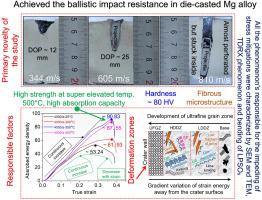实现轻量化Mg-Gd-Y-Zn合金抗7.62毫米反装甲钢芯弹丸的弹道抗冲击性;微观结构方法
IF 14.3
1区 材料科学
Q1 MATERIALS SCIENCE, MULTIDISCIPLINARY
引用次数: 0
摘要
在轻质镁(Mg)合金中实现抗弹道冲击是航空航天和军事工业的要求。然而,镁合金的抗弹道冲击性能较差,主要是由于其柔软的性质和六方密排(HCP)晶体结构。在目前的研究中,我们报道了压铸Mg-Gd-Y-Zn (WEZ)合金在低速和高速冲击下对7.62 mm钢芯弹丸具有很高的弹道抗冲击性。最具体地说,在344和605 m s - 1的速度下实现了完美的弹道抗冲击性,穿透深度分别为~ 12和~ 25 mm。此外,对于810 m s−1的非常高的速度,弹丸在板中受阻,但代价是在后表面上留下一个小孔/痂。其潜在原因是“纤维状微观结构”,由大量块状长周期堆积有序(LPSOs)、棒状长周期堆积有序(LPSOs)、层状长周期堆积有序(LPSOs)和一些稀土(RE)富集沉淀组成。这些“微观结构特征”就像纤维增强的α-Mg一样,在高温压缩(500°C)下,在高应变速率(~ 4000 s−1)下实现高强度,甚至比室温下的4000 s−1高得多,起着决定性的作用。因此,WEZ镁合金的这一特性导致其在高温下具有很高的吸收能力(90.83 ~ MJ m−3)。由于高温下的高强度、纤维微观结构和硬度(~ 80 HV),这种高吸收能力提供了对冲击和冲击波传播的高抗性。因此,弹丸经历了很高的抗穿孔阻力,因此,实现了弹道抗冲击性。最后但并非最不重要的是,后变形特征也有助于了解WEZ镁合金在弹道冲击过程中的应力缓解,这对于设计镁合金作为抗弹道冲击材料是有利的。本文章由计算机程序翻译,如有差异,请以英文原文为准。

Achieving ballistic impact resistance in a lightweight Mg-Gd-Y-Zn alloy against a 7.62 mm steel core projectile for anti-armor applications; a microstructural approach
Achieving ballistic impact resistance in a lightweight magnesium (Mg) alloy is a requirement of the aerospace and military industries. However, Mg alloy has poor ballistic impact resistance, mainly attributed to its soft nature and hexagonal close-packed (HCP) crystal structure. In the current study, we reported that the die-casted Mg-Gd-Y-Zn (WEZ) alloy displayed high ballistic impact resistance against a 7.62 mm steel core projectile under both low and high-velocity impact. Most specifically, a perfect ballistic impact resistance is achieved at velocities of 344 and 605 m s−1, having a depth of penetration of ∼ 12 and ∼ 25 mm, respectively. In addition, for a very high velocity of 810 m s−1, the projectile was impeded in the sheet but at the cost of a small hole/scab on the rear face. The potential reason is the “fibrous microstructure”, comprised of profuse blocky type long period stacking order (LPSOs), rod type LPSOs, lamellar LPSOs, and some rare earth (RE) enriched precipitates. These “microstructure features” act like a fiber reinforced α-Mg and play a decisive role in achieving high strength at super elevated temperature compression (500°C) under a high strain rate (∼ 4000 s−1), even much higher compared to 4000 s−1 at room temperature. As a result, this characteristic of WEZ Mg alloy leads to a high absorption capacity at elevated temperatures (90.83 ∼ MJ m−3). This high absorption capacity due to high strength at elevated temperatures, fibrous microstructure, and hardness (∼ 80 HV) offered high resistance to impact and shock wave propagation. Consequently, the projectile experienced a high resistance against perforation, and therefore, ballistic impact resistance was achieved. Last but not least, the post-deformation features also help in understanding the stress mitigation of WEZ Mg alloy during ballistic impact, which can be advantageous while designing Mg alloys as a ballistic impact-resistant material.
求助全文
通过发布文献求助,成功后即可免费获取论文全文。
去求助
来源期刊

Journal of Materials Science & Technology
工程技术-材料科学:综合
CiteScore
20.00
自引率
11.00%
发文量
995
审稿时长
13 days
期刊介绍:
Journal of Materials Science & Technology strives to promote global collaboration in the field of materials science and technology. It primarily publishes original research papers, invited review articles, letters, research notes, and summaries of scientific achievements. The journal covers a wide range of materials science and technology topics, including metallic materials, inorganic nonmetallic materials, and composite materials.
 求助内容:
求助内容: 应助结果提醒方式:
应助结果提醒方式:


